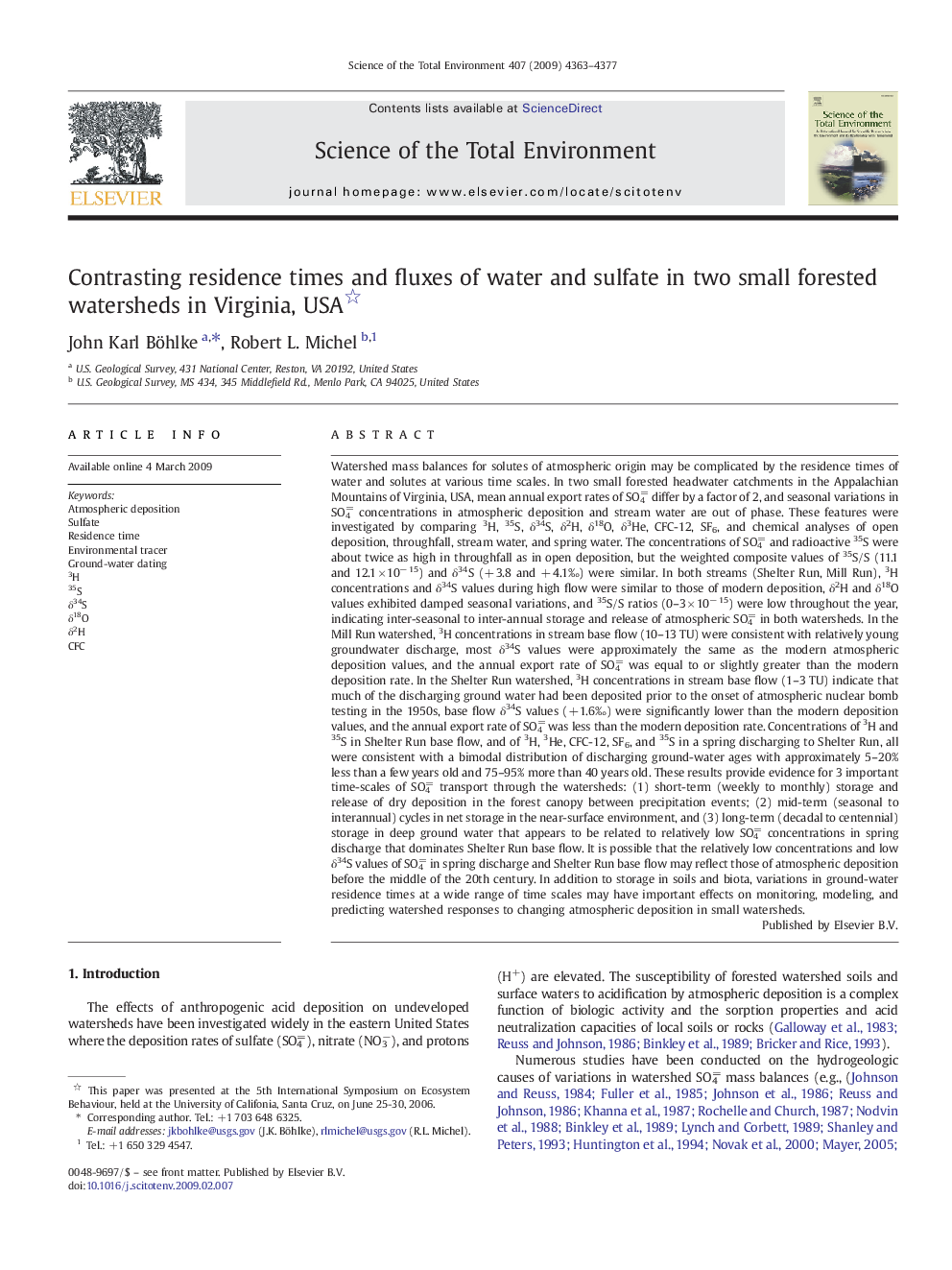| کد مقاله | کد نشریه | سال انتشار | مقاله انگلیسی | نسخه تمام متن |
|---|---|---|---|---|
| 4431759 | 1619896 | 2009 | 15 صفحه PDF | دانلود رایگان |

Watershed mass balances for solutes of atmospheric origin may be complicated by the residence times of water and solutes at various time scales. In two small forested headwater catchments in the Appalachian Mountains of Virginia, USA, mean annual export rates of SO4= differ by a factor of 2, and seasonal variations in SO4= concentrations in atmospheric deposition and stream water are out of phase. These features were investigated by comparing 3H, 35S, δ34S, δ2H, δ18O, δ3He, CFC-12, SF6, and chemical analyses of open deposition, throughfall, stream water, and spring water. The concentrations of SO4= and radioactive 35S were about twice as high in throughfall as in open deposition, but the weighted composite values of 35S/S (11.1 and 12.1 × 10− 15) and δ34S (+ 3.8 and + 4.1‰) were similar. In both streams (Shelter Run, Mill Run), 3H concentrations and δ34S values during high flow were similar to those of modern deposition, δ2H and δ18O values exhibited damped seasonal variations, and 35S/S ratios (0–3 × 10− 15) were low throughout the year, indicating inter-seasonal to inter-annual storage and release of atmospheric SO4= in both watersheds. In the Mill Run watershed, 3H concentrations in stream base flow (10–13 TU) were consistent with relatively young groundwater discharge, most δ34S values were approximately the same as the modern atmospheric deposition values, and the annual export rate of SO4= was equal to or slightly greater than the modern deposition rate. In the Shelter Run watershed, 3H concentrations in stream base flow (1–3 TU) indicate that much of the discharging ground water had been deposited prior to the onset of atmospheric nuclear bomb testing in the 1950s, base flow δ34S values (+ 1.6‰) were significantly lower than the modern deposition values, and the annual export rate of SO4= was less than the modern deposition rate. Concentrations of 3H and 35S in Shelter Run base flow, and of 3H, 3He, CFC-12, SF6, and 35S in a spring discharging to Shelter Run, all were consistent with a bimodal distribution of discharging ground-water ages with approximately 5–20% less than a few years old and 75–95% more than 40 years old. These results provide evidence for 3 important time-scales of SO4= transport through the watersheds: (1) short-term (weekly to monthly) storage and release of dry deposition in the forest canopy between precipitation events; (2) mid-term (seasonal to interannual) cycles in net storage in the near-surface environment, and (3) long-term (decadal to centennial) storage in deep ground water that appears to be related to relatively low SO4= concentrations in spring discharge that dominates Shelter Run base flow. It is possible that the relatively low concentrations and low δ34S values of SO4= in spring discharge and Shelter Run base flow may reflect those of atmospheric deposition before the middle of the 20th century. In addition to storage in soils and biota, variations in ground-water residence times at a wide range of time scales may have important effects on monitoring, modeling, and predicting watershed responses to changing atmospheric deposition in small watersheds.
Journal: Science of The Total Environment - Volume 407, Issue 14, 1 July 2009, Pages 4363–4377